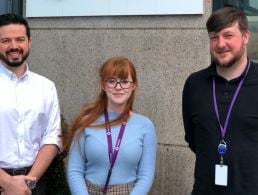LifeLabs Learning’s Tania Luna discusses how to encourage more inclusion at your workplace and become an advocate for your staff.
No matter what industry you’re in, diversity and inclusion should be two items at the top of your company’s priority list.
Tania Luna, co-CEO of LifeLabs Learning, believes that the most effective way to encourage more inclusion is by being an ally and supporting your coworkers. She talked to Siliconrepublic.com about the importance of this approach, and how businesses can take measurable steps towards it.
What is inclusion?
According to Luna, it’s vital that businesses nail down their definition of inclusion before they set out to try and achieve it.
She explained her method of breaking down the concept into two categories, micro-inclusion and macro-inclusion, to inform your strategy and effect real change.
“Micro-inclusion means inviting people to participate. The litmus test to use here is, ‘Are we truly making space for each voice?’ Macro-inclusion refers to creating systems that provide equal access to opportunities, particularly in areas of the business most vulnerable to bias.”
Examples she offered here include structured interviewing, transparent salary formulas, and social events that are broadly accessible and enjoyable for everyone.
‘Even if we know it will make for a better party, we choose a sense of comfort over the courage it takes to connect’
– TANIA LUNA
“The goal of these initiatives is to fill in some of our historic and societal ‘access gaps’, so we can all benefit from greater diversity of experience and perspective, which are predictors of innovation and revenue growth,” she added.
Imagine yourself as a party planner
Luna described some parallels between the process of planning a party and taking steps to create a more inclusive workplace.
“If people don’t know about the party, they can’t attend. When it comes to hiring, it works the same way.”
And that’s only the beginning, she added. “We need fair, structured interviewing processes so that we don’t invite people to the party and then keep them from getting through the door.”
Once people arrive at the party, she continued, they need to be made to feel welcome, especially if there’s a possibility that they’ll feel out of place.
“I don’t want them to stand alone in the corner while my friends dance in the middle of the room and laugh together in small circles. A good host asks people how they’re doing, makes introductions and tries to show guests they’re wanted, even if – especially if – their dance moves look different.”
One of the main problems is that many employees don’t have the skills to implement inclusion. Like they would at a party, they tend to hang around the people they feel most comfortable around.
“Even if we know it will make for a better party, we choose a sense of comfort over the courage it takes to connect,” Luna said.
“Lastly, at my imaginary party, I want everyone to have a good time and fully participate. But this is inherently hard because my friends and I have been throwing this party for many years now, and we have an implicit view of what makes a good party.
“We’ve designed the entire experience based on our preferences, like music and food, so we assume everyone else will love it too.
“In the same way at work, individuals in positions of power and influence, who also typically come from historically dominant groups, find it difficult to see that not everyone ‘parties’ like they do.
“So, they have to put in greater effort to hear out people’s needs and exercise humility to recognise there are ways to make this party better.”
Taking the first step
If you’re just starting on your workplace journey towards inclusion, the road ahead can sometimes seem insurmountable. Luna’s advice for anyone in this position is simple: start small.
This is where the micro-inclusions come in, which can be used in the form of small, everyday invitations to participate.
One example that Luna provided is to ask employees in a one-on-one setting how they feel, and whether there’s anything you can do to help them bring their best selves to work.
‘Inclusion isn’t an add-on, it is foundational to being a great leader’
– TANIA LUNA
“Model vulnerability by mentioning mistakes you’ve made in the past and feedback you’ve received. These are signal-setting actions that make it easier for others to share their concerns and feedback.”
Another clue that can be telling is turn-taking during meetings. If some people are speaking up far less than their colleagues, it might be time to check in with them or review any potential causes of their reluctance.
Being an advocate for your workers
Luna drew on the research that LifeLabs Learning has carried out, delving into what distinguishes great managers and showing the large part that inclusivity plays.
“What we found is that the most effective managers are also the most inclusive managers. Inclusion isn’t an add-on, it is foundational to being a great leader.
“So, if organisations want to thrive and hit their goals, they need to help leaders and teams get good at leveraging the differences that people bring to work.
“Make it explicit. Let people know you value diversity – visible and invisible differences. Ask for feedback on access, fairness and inclusion one-on-one and in company-wide surveys. When you get feedback, let all employees know how you’re taking action.”




